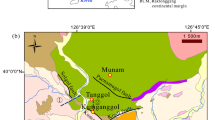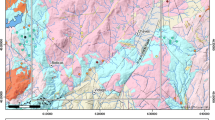Abstract
This study evaluates the capability of Advanced Land Imager (ALI) and Hyperion Earth Observing-1 (EO1) data for lithological and hydrothermal alteration mapping. Several image processing methods were applied to ALI and Hyperion images covering the Meiduk and Sar Cheshmeh porphyry copper mining districts, SE Iran. Feature-oriented principal components selection, developed band ratio and minimum noise fraction methods were able to yield spectral information for enhancing the hydrothermally altered rocks and lithological units at regional scale using ALI data. Mixture-tuned matched-filtering method discriminated hydrothermal alteration areas from surrounding rock units using shortwave infrared bands of ALI. Analytical imaging and geophysics (AIG)-developed hyperspectral analysis processing methods were applied to the visible and near infrared and shortwave infrared bands of Hyperion for mapping iron oxide/hydroxide minerals and clay mineral assemblages at district scale. Supergene altered areas consisting of iron oxide/hydroxide minerals such as hematite, limonite, jarosite and goethite were detected using visible and near infrared bands of Hyperion. Phyllic, advanced argillic and propylitic alteration zones associated with porphyry copper mineralization were discriminated using shortwave infrared bands of Hyperion. The achievements of this investigation indicate considerable implications for geologists to use Earth Observing-1 data for porphyry copper and epithermal gold exploration.












Similar content being viewed by others
References
ACORN TM 5.0. (2004). Tutorial, ImSpec LLC, A dvanced Imaging and Spectroscopy, ImSpec LLC.
Bhadra, B. K., Pathak, S., Karunakar, G., & Sharma, J. R. (2013). ASTER data analysis for mineral potential mapping around Sawar-Malpura area, Central Rajasthan. Journal of the Indian Society of Remote Sensing, 41(2), 391–404.
Bishop, C. A., Liu, J. G., & Mason, P. J. (2011). Hyperspectral remote sensing for mineral exploration in Pulang, Yunnan Province, China. International Journal of Remote Sensing, 32(9), 2409–2426.
Boardman, J. W. (1998). Leveraging the high dimensionality of AVIRIS data for improved sub-pixel target unmixing and rejection of false positives: mixture tuned matched filtering, in: Summaries of the Seventh Annual JPL Airborne Geoscience Workshop, Pasadena, CA, pp. 55.
Crosta, A. P., Souza Filho, C. R., Azevedo, F., & Brodie, C. (2003). Targeting key alteration minerals in epithermal deposits in Patagonia, Argentina, Using ASTER imagery and principal component analysis. International Journal of Remote Sensing, 24, 4233–4240.
Cudahy, T.J., & Barry, P.S. (2002). Earth magmatic-seawater hydrothermal alteration revealed through satellite-borne Hyperion imagery at Panorama, Western Australia. IEEE IGARSS proceeding, vol, I. p. 590–592.
Cudahy, T. J., Hewson, R., Huntington, J. F., Quigley, M. A., & Barry, P. S. (2001). The performance of the satellite-borne Hyperion hyperspectral VNIR-SWIR imaging system for mineral mapping at Mount Fitton, South Australia. IEEE IGARSS proceeding, p. 9–13.
Gersman, R., Ben-Dor, E., Beyth, M., Avigad, D., Abraha, M., & Kibreab, A. (2008). Mapping of hydrothermally altered rocks by the EO-1 Hyperrion sensor, northern Danakil, Eritrea. International Journal of Remote Sensing, 29(13), 3911–3936.
Green, A. A., Berman, M., Switzer, P., & Craig, M. D. (1988). A transformation for ordering multispectral data in terms of image quality with implications for noise removal. IEEE Transaction Geosciences and Remote Sensing, 26(1), 65–74.
Hashim, M., Pour, B. A., & Wei, C. K. (2014). Comparison of ETM+ and MODIS data for tropical forest degradation monitoring in the Peninsular Malaysia. Journal of the Indian Society of Remote Sensing, 42(2), 383–396.
Hubbard, B. E., & Crowley, J. K. (2005). Mineral mapping on the Chilean–Bolivian Altiplano using co-orbital ALI, ASTER and Hyperion imagery: data dimensionality issues and solutions. Remote Sensing of Environment, 99, 173–186.
Hubner, H. (1969a). Geological map of Iran sheet no. 5, south central Iran: Tehran, National Iranian Oil Company, scale 1:1,000,000.
Hubner, H. (1969b). Geological map of Iran sheet no. 6, southeast Iran: Tehran, National Iranian Oil Company, scale 1:1,000,000.
Hunt, G. R., & Ashley, P. (1979). Spectra of altered rocks in the visible and near infraraed. Economic Geology, 74, 1613–1629.
Kruse, F. A., Lefkoff, A. B., Boardman, J. W., Heidebrecht, K. B., Shapiro, A. T., Barloon, P. J., & Goetz, A. F. H. (1993). The spectral image processing system (SIPS) – interactive visualization and analysis of imaging spectrometer data. Remote Sensing of Environment, 44, 145–163.
Kruse, F. A., Bordman, J. W., & Huntington, J. F. (2003). Comparison of airborne hyperspectral data and EO-1 Hyperion for mineral mapping. IEEE Transaction Geosciences and Remote Sensing, 41(6), 1388–1400.
Kruse, F. A., Perry, S. L., & Caballero, A. (2006). Distict-level mineral survey using airborne hyperspectral data, Los Menucos, Argentina. Annals of Geophysics, 49(1), 83–92.
Pazand, K., Sarvestani, J. F., & Ravasan, M. R. S. (2013). Hydrothermal alteration mapping using ASTER data for reconnaissance porphyry copper mineralization in the Ahar area, NW Iran. Journal of the Indian Society of Remote Sensing, 41(2), 379–389.
Pearlman, J. S., Barry, P. S., Segal, C. C., Shepanski, J., Beiso, D., & Carman, S. L. (2003). Hyperion, a space-based imaging spectrometer. IEEE Transaction Geosciences and Remote Sensing, 41(6), 1160–1173.
Pour, B. A., & Hashim, M. (2011a). Identification of hydrothermal alteration minerals for exploring of porphyry copper deposit using ASTER data, SE Iran. Journal of Asian Earth Sciences, 42, 1309–1323.
Pour, B. A., & Hashim, M. (2011b). Spectral transformation of ASTER and the discrimination of hydrothermal alteration minerals in a semi-arid region, SE Iran. International Journal of the Physical Sciences, 6(8), 2037–2059.
Pour, B. A., & Hashim, M. (2011c). Application of spaceborne thermal emission and reflection radiometer (ASTER) data in geological mapping. International Journal of the Physical Sciences, 6(33), 7657–7668.
Pour, B. A., & Hashim, M. (2011d). The earth observing-1 (EO-1) satellite data for geological mapping, southeastern segment of the Central Iranian Volcanic Belt, Iran. International Journal of the Physical Sciences, 6(33), 7638–7650.
Pour, B. A., & Hashim, M. (2012a). The application of ASTER remote sensing data to porphyry copper and epithermal gold deposits. Ore Geology Reviews, 44, 1–9.
Pour, B. A., & Hashim, M. (2012b). Identifying areas of high economic-potential copper mineralization using ASTER data in Urumieh-Dokhtar Volcanic Belt, Iran. Advances in Space Research, 49, 753–769.
Pour, A. B., & Hashim, M. (2013). Fusing ASTER, ALI and Hyperion data for enhanced mineral mapping. International Journal of Image and Data Fusion, 4(2), 126–145.
Pour, B. A., & Hashim, M. (2014). Structural geology mapping using PALSAR data in the Bau gold mining district, Sarawak, Malaysia. Advances in Space Research, 54(4), 644–654.
Pour, B. A., & Hashim, M. (2015). Structural mapping using PALSAR data in the Central Gold Belt, Peninsular Malaysia. Ore Geology Reviews, 64, 31–22.
Pour, B. A., Hashim, M., & Marghany, M. (2011). Using spectral mapping techniques on short wave infrared bands of ASTER remote sensing data for alteration mineral mapping in SE Iran. International Journal of the Physical Sciences, 6(4), 917–929.
Pour, B. A., Hashim, M., & van Genderen, J. (2013). Detection of hydrothermal alteration zones in a tropical region using satellite remote sensing data: Bau gold field, Sarawak, Malaysia. Ore Geology Reviews, 54, 181–196.
Pour, B. A., Hashim, M., & Marghany, M. (2014). Exploration of gold mineralization in a tropical region using Earth Observing-1 (EO1) and JERS-1 SAR data: a case study from Bau gold field, Sarawak, Malaysia. Arabian Journal of Geosciences, 7, 2393–2406.
Ungar, S. G., Pearlman, J. S., Mendenhall, J. A., & Reuter, D. (2003). Overview of the earth observing one (EO-1) mission. IEEE Transaction Geosciences and Remote Sensing, 41(6), 1149–1159.
Waterman, G. C., & Hamilton, R. L. (1975). The Sarcheshmeh porphyry copper deposit. Economic Geology, 70, 568–576.
Wulder, M. A., White, J. C., Goward, S. N., Irons, J. R., Herold, M., Cohen, W. B., Loveland, T. R., & Woodcock, C. E. (2008). Landsat continuity: issues and opportunities for land cover monitoring. Remote Sensing of Environment, 112, 955–969.
Acknowledgments
This was study conducted as part of Fundamental Research Grant Scheme, Ministry of Higher Education Malaysia. We are thankful to the Universiti Teknologi Malaysia for providing the facilities for this investigation. We also would like to express our great appreciation to the anonymous reviewers and Prof. Dr. Vinay Kumar Dadhwal for their very useful and constructive comments and suggestions for improvement of this manuscript.
Author information
Authors and Affiliations
Corresponding author
About this article
Cite this article
Pour, A.B., Hashim, M. Evaluation of Earth Observing-1 (EO1) Data for Lithological and Hydrothermal Alteration Mapping: A Case Study from Urumieh-Dokhtar Volcanic Belt, SE Iran. J Indian Soc Remote Sens 43, 583–597 (2015). https://doi.org/10.1007/s12524-014-0444-y
Received:
Accepted:
Published:
Issue Date:
DOI: https://doi.org/10.1007/s12524-014-0444-y




